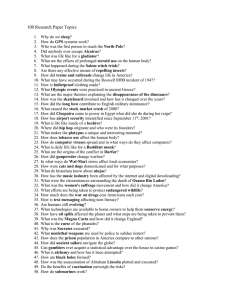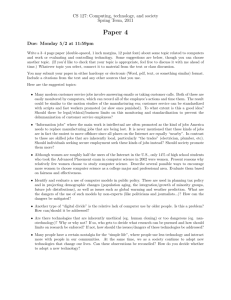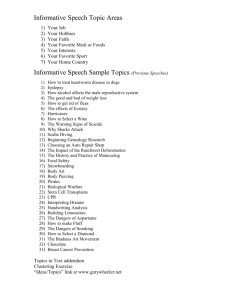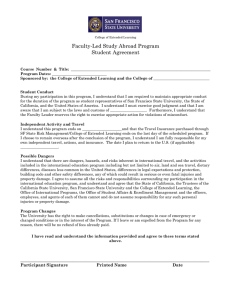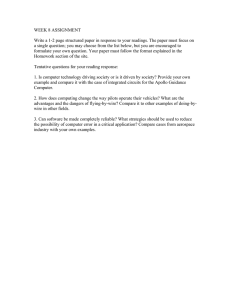Health and Safety in LPSCS Careers
advertisement
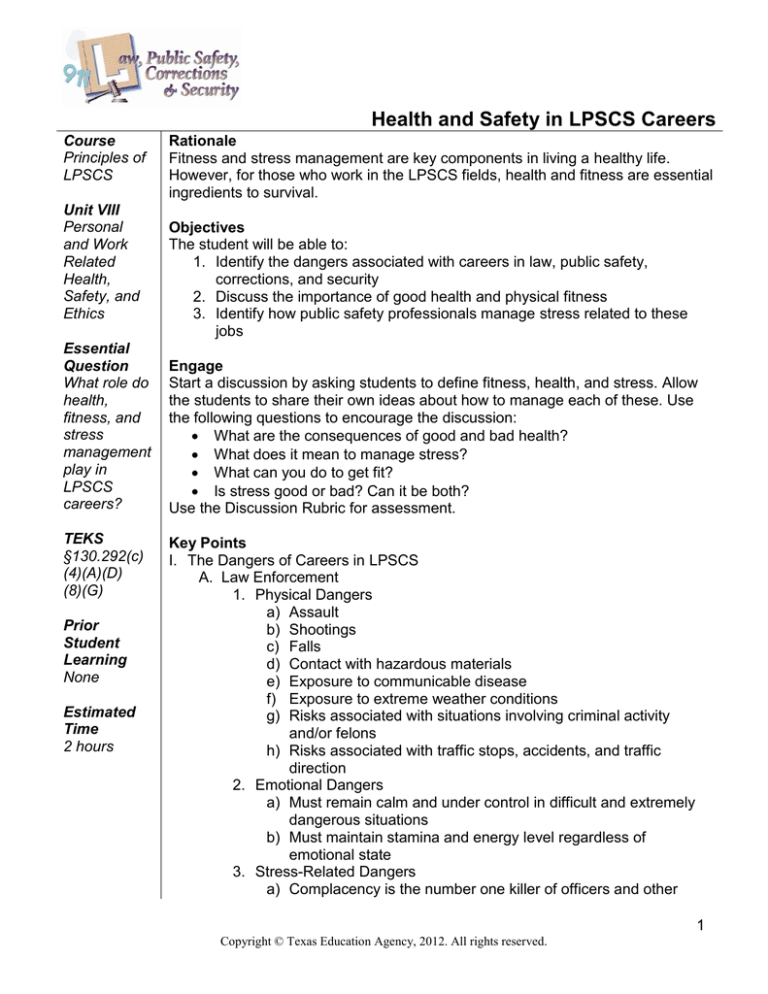
Health and Safety in LPSCS Careers Course Principles of LPSCS Unit VIII Personal and Work Related Health, Safety, and Ethics Essential Question What role do health, fitness, and stress management play in LPSCS careers? TEKS §130.292(c) (4)(A)(D) (8)(G) Prior Student Learning None Estimated Time 2 hours Rationale Fitness and stress management are key components in living a healthy life. However, for those who work in the LPSCS fields, health and fitness are essential ingredients to survival. Objectives The student will be able to: 1. Identify the dangers associated with careers in law, public safety, corrections, and security 2. Discuss the importance of good health and physical fitness 3. Identify how public safety professionals manage stress related to these jobs Engage Start a discussion by asking students to define fitness, health, and stress. Allow the students to share their own ideas about how to manage each of these. Use the following questions to encourage the discussion: What are the consequences of good and bad health? What does it mean to manage stress? What can you do to get fit? Is stress good or bad? Can it be both? Use the Discussion Rubric for assessment. Key Points I. The Dangers of Careers in LPSCS A. Law Enforcement 1. Physical Dangers a) Assault b) Shootings c) Falls d) Contact with hazardous materials e) Exposure to communicable disease f) Exposure to extreme weather conditions g) Risks associated with situations involving criminal activity and/or felons h) Risks associated with traffic stops, accidents, and traffic direction 2. Emotional Dangers a) Must remain calm and under control in difficult and extremely dangerous situations b) Must maintain stamina and energy level regardless of emotional state 3. Stress-Related Dangers a) Complacency is the number one killer of officers and other 1 Copyright © Texas Education Agency, 2012. All rights reserved. public safety professionals (Kahlberg, 2012) b) Immediate and dramatic situational changes c) States of high alert for extended periods of time d) Shift work and long hours (1) Cause exhaustion and an inability to stay alert (2) Increase the risk of falling asleep during a shift (3) Impede the ability to participate in a healthy family life 4. Statistics a) High divorce rate b) High rate of alcoholism c) High rate of suicide B. Correctional Services 1. Physical Dangers a) Working with violent offenders b) Carrying minimal protection (weapons) c) Contact with hazardous materials d) Exposure to communicable diseases e) Receiving assaults and/or threats from offenders f) The risk of being stabbed, pricked, or cut during cell searches g) Working outnumbered in the facility, dorm, and recreation yard h) Target of gangs in the free world 2. Emotional Dangers a) Tough attitudes get carried into personal relationships b) Complacency leads to death C. Fire Services 1. Physical Dangers a) Fires of all types b) Falling debris c) Falls d) Smoke e) Communicable diseases f) Hazardous materials g) Bombs h) Separation from the team during dangerous activities i) Search and rescue risks in dangerous locations or during emergencies j) Electrical power lines that have fallen k) Fatigue from physical demands D. Security Services 1. Physical Dangers a) Working in dangerous locations (i.e., overseas during a war) b) Often working unarmed c) Mistaken for police by offenders d) Receiving much less training than police e) Suffering many of the same dangers as law enforcement 2 Copyright © Texas Education Agency, 2012. All rights reserved. II. Fitness and Wellness A. Key Terms 1. Physical Fitness – “the condition of the body which enables an individual to use his or her body in activities requiring strength, muscular endurance, cardiovascular endurance, flexibility, coordination, agility, power, balance, speed, and accuracy, without the undue experience of fatigue and exhaustion” (TCLEOSE) 2. Wellness – “a state of positive well-being [that] induces the physical, mental, spiritual, and socio-emotional dimensions of life...translates into the practice of positive lifestyle behaviors and good health habits” (TCLEOSE) B. Health and disability status of law enforcement includes a high incidence of stress-related disorders (TCLEOSE) 1. 30% suffer from alcoholism 2. 28% are divorced 3. The suicide rate is twice the rate of officers killed on duty C. The importance of fitness 1. Physical health a) Reduces coronary risk b) Minimizes hypo-kinetic disease c) Promotes weight reduction and control d) Improves fatigue tolerance e) Increases energy production 2. Emotional health a) Decreases anxiety and depression b) Improves self confidence c) Increases the ability to deal with stress 3. Job performance a) Increases alertness and productivity b) Reduces absenteeism and healthcare costs III. Stress Management A. Individual stressors 1. Fears regarding job competencies or success a) This is especially true for new officers b) They often worry about doing the job correctly and remembering all of the information they have been taught 2. Necessity to conform – officers often find that they must conform to the norms of their department in order to fit in 3. Necessity to take a second job – many officers get into serious debt and need to work “off-duty” jobs 4. Altered social status – most often difficult for women because of the chauvinism still present in many LPSCS professions 5. Frequent exposure to life’s miseries 6. Rigors of police work (shift work, exposure to elements, physical demands, etc.) 3 Copyright © Texas Education Agency, 2012. All rights reserved. B. C. D. E. F. 7. Boredom – officers often perceive that there is nothing to do if they are not on an assigned call 8. Fears and dangers of the job 9. Responsibilities are great – failure to meet obligations could result in physical harm (of self or others) and/or civil (monetary) suits 10. Work overload – shifts may be understaffed, causing officers to work more cases than they can possibly clear 11. Fragmented nature of calls (i.e., an emergency shooting one minute and then no call for hours) Emotional/relational symptoms of excessive stress 1. Divorce 2. Alcoholism 3. Suicide 4. Abrupt behavior changes 5. Overly suspicious/hostile 6. Fearful 7. Depressed 8. Antisocial Physical symptoms of excessive stress 1. Digestive disorders 2. Headaches 3. Excessive illness 4. High blood pressure 5. Sleep disorders 6. Back, neck, and/or shoulder pain 7. Increases or decreases in weight Appropriate methods of coping with stress 1. Exercise 2. Recreation 3. Hobbies 4. Eating a nutritious, balanced diet 5. Communicating with others 6. Relaxation 7. Time management techniques Inappropriate methods of handling stress 1. Alcohol and/or Drugs a) Evaluate your own use of alcohol and/or drugs b) Report and assist coworkers who are experiencing alcohol or drug problems (1) Be aware and recognize the problem (2) Urge the coworker to seek help (3) Encourage the coworker after they seek help 2. Overeating 3. Inflicting anger on others 4. Holding stress inside Tips for getting along with others 4 Copyright © Texas Education Agency, 2012. All rights reserved. 1. Do not act like a know-it-all 2. Do not act intimidated 3. Do not make excuses 4. Do not be sensitive to teasing or ridicule 5. Do compliment others 6. Do ask for help if you do not have the answer G. Time Management Techniques 1. Wake up in time to eat a healthy breakfast a) Rushing can (1) Lead to skipping breakfast (2) Cause unwanted stress (i.e., speeding to avoid being late) b) Adequate sleep and preparedness are important to successfully completing a stressful shift 2. Determine your top priorities a) Prioritize your list according to importance, not how easily a task can be completed b) Give yourself credit for the tasks you accomplish during the day instead of getting frustrated about the tasks you did not accomplish 3. Get organized a) Do not waste time and energy looking for misplaced items b) Arrange a specific place for files and tools, and return them after use c) Create a filing system to avoid paperwork pileup d) Use color coding to make items easier to find e) Do not save everything you think you might need someday; clutter makes it difficult to find what you really need 4. Conquer procrastination a) Do not waste time worrying b) Break big jobs down into smaller tasks c) Delegate or let go of tasks that are not important to you 5. Learn to say “no” a) Do not overcommit yourself b) Compromise when it comes to your partner or family c) Remember family support is important to stress management 6. Protect your “prime time” a) Chose a time to do your priority work b) Eliminate all distractions in order to make the most of your time 7. Keep weekends for you a) Get proper relaxation to reduce stress, restore energy, and avoid physical and mental fatigue b) Try to complete essential household chores throughout the week so they do not stack up during the weekend c) Do not worry about unimportant tasks; let the rest go d) Concentrate on your top priorities e) Complete weekend chores early so that the rest of the 5 Copyright © Texas Education Agency, 2012. All rights reserved. weekend is free to enjoy Activities 1. Stress Reduction Suggestions Worksheet. Have the students complete the Stress Reduction Suggestions Worksheet. Discuss how each of the stress reduction strategies can be applied to the students’ lives. Use the Stress Reduction Suggestions Worksheet Key to guide the discussion. Use the Discussion Rubric for assessment. 2. Fitness Plan. Have students prepare a personal health and fitness program that includes a healthy diet and exercise plan. Each student must create a well-balanced diet and exercise regimen for a full seven days. The diet must include three meals and two snacks a day, along with appropriate beverages. The exercise plan must include both cardio and strength training. The students may research and use pre-existing exercise plans or programs if they adapt them to their own fitness needs. For example, if a student currently uses a commercial workout system, he or she needs to determine how to maximize the results by scheduling certain workouts on specific days. He or she may also choose to use and adapt a commercial diet plan. Use the Individual Work Rubric for assessment. Assessments Health and Safety in LPSCS Careers Exam and Key Stress Reduction Suggestions Worksheet and Key Discussion Rubric Individual Work Rubric Research Rubric Materials Health and Safety in LPSCS Careers computer-based presentation Computers with Internet access Resources Texas Commission on Law Enforcement Officer Standards and Education (TCLEOSE) Fitness Wellness and Stress training materials http://www.tcleose.state.tx.us/Documents/training/1000_01_fitwellstress.doc Do an Internet search for the following: Law enforcement careers tips disadvantages of law enforcement careers Being a firefighter what is involved in this noble profession 443052 Marc Kahlberg, Complacency Kills, Law Enforcement Today Accommodations for Learning Differences For reinforcement, students will research the requirements for a well-balanced diet. Students will then base their diet plan on the required daily allowances for each of the food groups. Use the Research Rubric for assessment. 6 Copyright © Texas Education Agency, 2012. All rights reserved. For enrichment, students will research the effects of stress in LPSCS careers. Students must include statistical data reporting the negative effects of stress and the positive ways to manage stress in these careers. Use the Research Rubric for assessment. State Education Standards Texas Essential Knowledge and Skills for Career and Technical Education §130.292. Principles of Law, Public Safety, Corrections, and Security (One-Half to One Credit). (4) The student implements measures to maintain safe and healthful working conditions in a law and public safety environment. The student is expected to: (A) identify the dangers associated with careers in law, public safety, corrections, and security; (D) discuss the importance of good health and physical fitness; and (8) The student identifies the roles of the public safety professional. The student is expected to: (G) identify how public safety professionals manage the stress related to these jobs College and Career Readiness Standards English/Language Arts Standards V. Research A. Formulate topic and questions. 1. Formulate research questions. 2. Explore a research topic. 7 Copyright © Texas Education Agency, 2012. All rights reserved. Name________________________________ Date__________________________ Health and Safety in LPSCS Careers Exam 1. _____ There are many dangers associated with a career in law enforcement. Which of these is not one of the types of dangers discussed? A. Stress-related dangers B. Emotional dangers C. Psychological dangers D. Physical dangers 2. _____ Law enforcement officers are at risk from physical dangers on a daily basis. Which of the dangers below is not a physical danger? A. Exposure to communicable disease B. Staying on high alert for extended periods C. Risks from traffic stops, accidents, and directing traffic D. Falls 3. _____ Emotional dangers of law enforcement would include which of the following? A. Remaining stoic in difficult situations B. Shootings C. High divorce rates D. Exposure to extreme weather conditions 4. _____ Shift work, long hours, being tired and unable to remain alert, falling asleep on the job, and working shifts not conducive to family life are all examples of which type of law enforcement danger? A. Physical dangers B. Emotional dangers C. Stress-related dangers D. Statistics 5. _____ Correctional officers are at risk from many of the same dangers as law enforcement officers. Which of the following is one of the biggest dangers correctional officers face in relation to their law enforcement counterparts? A. Contact with hazardous materials B. Carry little protection (weapons) C. Assault/threats D. Exposure to communicable disease 6. _____ Correctional officers are prone to an emotional danger that can ruin their home life. Which of the following would cause significant problems in relationships? A. Tough attitude from work carried into personal relationships B. Working with violent offenders C. Danger of being stabbed, pricked, or cut D. Targeted by gang members in the free world 8 Copyright © Texas Education Agency, 2012. All rights reserved. 7. _____ Fire Services is probably the most dangerous of all the careers in this field. Every encounter could be the last for firefighters. Which of these is not a physical danger faced by firefighters? A. Fires B. Separation from the team C. Shopping for meals D. Falling debris 8. _____ Depending on the type of assignment in the security field, the physical dangers may be similar to law enforcement. Which of the following is not a physical danger of security services personnel? A. Often unarmed B. Less trained than law enforcement officers C. Work in war zones overseas D. Monitor cameras for employee thefts 9. _____ “The condition of the body which enables an individual to use his or her body in activities requiring strength, muscular endurance, cardiovascular endurance, flexibility, coordination, agility, power, balance, speed and accuracy, without the undue experience of fatigue and exhaustion” (TCLEOSE) defines which of the following key terms? A. Wellness B. Physical fitness C. Stress management D. Health 10. _____ Which of the following is not a high-risk incidence for law enforcement? A. Mental illness B. Alcoholism C. Divorce D. Suicide 11. _____ Which of the following is not an area that physical fitness impacts? A. Physical health B. Overall wellness C. Emotional health D. Job performance 12. _____ Physical fitness reduces coronary risk, minimizes hypo-kinetic disease, controls weight, improves fatigue tolerance, and which of the following? A. Increases energy production B. Reduces absenteeism C. Increases productivity D. Increases alertness 9 Copyright © Texas Education Agency, 2012. All rights reserved. 13. _____ Which of the following is not a consequence that physical fitness has on emotional health? A. Decreases anxiety and depression B. Improves self confidence C. Reduces healthcare costs D. Improves a person’s ability to deal with stress 14. _____ Which of the following is not a factor affecting job performance? A. Increased alertness B. Increased fatigue tolerance C. Increased productivity D. Reduced absenteeism 15. _____ Common stressors that officers face are the financial necessity of a second job, altered social status, and fear about job performance. All of these stressors are considered which of the following? A. Emotional symptoms of stress B. Physical symptoms of stress C. Individual stressors D. Appropriate methods of coping with stress 16. _____ Which of the following are individual stressors related to the stress management of law enforcement officers? A. Frequent exposure to life’s miseries B. Rigors of police work C. Fragmented nature of job D. All of the above 17. _____ Abrupt behavior changes, depression, alcoholism, and anti-social behavior are all symptoms of which type of stress? A. Emotional stress B. Physical stress C. Appropriate methods of coping D. Individual stressors 18. _____ Digestive disorders, headaches, high blood pressure, increased/decreased weight, and back, neck, or shoulder pain are all symptoms of what type of stress? A. Emotional stress B. Appropriate stress C. Individual stressors D. Physical stress 10 Copyright © Texas Education Agency, 2012. All rights reserved. 19. _____ Which of the following are appropriate methods for dealing with stress? A. Incorporate time management techniques B. Drug or alcohol use C. Eating D. Holding feelings inside 20. _____ Which of the following is not an appropriate method for coping with stress? A. Exercise B. Relaxation C. Taking it out on others D. Communication with others 21. _____ Which of the following is inappropriate when dealing with drug or alcohol use? A. Evaluate your own use of drugs and alcohol B. Assist coworkers by keeping their use secret C. Urge coworkers to seek help D. Encourage coworkers after they seek help 22. _____ Which of the following is an ineffective way to relate to others? A. Acting like a know-it-all B. Making no excuses C. Complimenting others D. Asking when uncertain 23. _____ Which of the following is not a time management technique? A. Get up when the alarm goes off so that you do not rush to avoid lateness B. Prioritize your list of things to do and start with the most important task C. If it is not important to you, delegate it or let it go D. Keep all items that you think you might need later 24. _____ Which of the following would not be part of the time management technique of getting organized? A. Prioritize your list according to importance B. Arrange a specific place to put items and return them to that place after use C. Create a filing system for paperwork D. Use a color coding system to make things easier to find 25. _____ Which of these is not a time management technique: A. Conquer procrastination B. Remember that your weekends are for work C. Learn to say no D. Protect your prime time 11 Copyright © Texas Education Agency, 2012. All rights reserved. 26. _____ Who should we learn to compromise with when learning to say no? A. Friends B. Co-workers C. Family D. Boss 27. _____ Which of these statements does not reflect the “weekends are for you” technique? A. Eliminate all distractions and make the most of your time B. Try to keep up with household chores during the week C. Do the things that are important and let the rest go D. If you do have chores, get them done early 28. _____ Work overload (shift understaffed) falls under which category of stress management? A. Emotional symptoms of stress B. Physical symptoms of stress C. Individual stressors D. Appropriate methods for coping with stress 29. _____ Which of the following is one of the biggest dangers in LPSCS jobs? A. Physical dangers B. Complacency C. Emotional dangers D. Stress-related dangers 12 Copyright © Texas Education Agency, 2012. All rights reserved. Health and Safety in LPSCS Careers Exam Key 1. C 2. B 3. A 4. C 5. B 6. A 7. C 8. D 9. B 10. A 11. B 12. A 13. C 14. B 15. C 16. D 17. A 18. D 19. A 20. C 21. B 22. A 23. D 24. A 25. B 26. C 27. A 28. C 29. B 13 Copyright © Texas Education Agency, 2012. All rights reserved. Name________________________________ Date__________________________ Stress Reduction Suggestions Worksheet 1. The most important element in keeping your work stress at manageable, healthy levels is your ______________________. Accept that life is not easy and it is not fair. You will be challenged with one problem after another. How you handle problems personally is very important. Life would be boring without challenges. Resolve to balance your work world as well as possible, and then develop strategies for using stress rather than allowing it to use you. 2. ____________ __ _________________, don’t take your job and yourself so seriously. Laughter will lower tension. Concentrate on the positive instead of the negative things in life. 3. __________________ relax your muscles. We all have tendencies to tense up our muscles under stress, particularly the jaw, neck, and shoulder muscles. Try to recognize where you tense up under stress, take deep breaths, and concentrate on relaxing. Stretch your neck and rotate your shoulders. Take opportunities to get out of your car. 4. Use positive ________-__________. En route to a stressful call, picture yourself handling it safely and correctly, just as you usually do. 5. Seek ________________ to unwind from stressful situations you have just encountered. Get your thoughts together for the report while listening to relaxing music. 6. Avoid drinking excessive amounts of __________________. The caffeine in two cups of coffee adds about 16 beats a minute to your heart rate and makes you more irritable and anxious, reducing your coping skills. 7. Identify your weak areas; work on strengthening them, thereby increasing your _________________. The more confident you are in your job, the fewer problems you will have controlling your emotions. 8. ________________ regularly. Most people already know that exercise is a valuable tool in stress reduction. Obviously, if you are physically fit, you feel better mentally and physically. You have a self-confidence that many do not possess, but there is more to it than that. A good workout raises the body temperature slightly, which imparts a sense of relaxation. Add to that the fact that steady exercise can affect brain chemistry and heighten your feelings of well-being and self-esteem. It does this by increasing the levels of neurotransmitters such as serotonin, dopamine, and epinephrine, which can lead to euphoric feelings. Additionally, exercise reduces muscle tension caused by anxiety. 9. ____________________ __________________ _____. Often, law enforcement officers keep their problems to themselves. Instead, create a support group of friends that you feel comfortable talking with. You may be surprised how others respond when you express that you value their opinion on a problem or an issue. 10. ____________ to your __________________. Since you are what you do, do good and you will feel good. If something doesn’t feel right, it probably isn’t. 14 Copyright © Texas Education Agency, 2012. All rights reserved. Stress Reduction Suggestions Worksheet Key 1. attitude 2. laugh a little 3. consciously 4. self-talk 5. solitude 6. coffee 7. confidence 8. exercise 9. talk about it 10. listen to your conscience 15 Copyright © Texas Education Agency, 2012. All rights reserved. Name_______________________________________ Date_______________________________ Discussion Rubric Objectives 4 pts. Excellent 3 pts. Good 2 pts. Needs Some Improvement 1 pt. Needs Much Improvement N/A Pts. Participates in group discussion Encourages others to join the conversation Keeps the discussion progressing to achieve goals Shares thoughts actively while offering helpful recommendations to others Gives credit to others for their ideas Respects the opinions of others Involves others by asking questions or requesting input Expresses thoughts and ideas clearly and effectively Total Points (32 pts.) Comments: 16 Copyright © Texas Education Agency, 2012. All rights reserved. Name______________________________________ Date_______________________________________ Individual Work Rubric 4 pts. Excellent Objectives 3 pts. Good 2 pts. Needs Some Improvement 1 pt. Needs Much Improvement N/A Pts. Follows directions Student completed the work as directed, following the directions given, in order and to the level of quality indicated Time management Student used time wisely and remained on task 100% of the time Organization Student kept notes and materials in a neat, legible, and organized manner. Information was readily retrieved Evidence of learning Student documented information in his or her own words and can accurately answer questions related to the information retrieved *Research/Gathering information (if relevant) Student used a variety of methods and sources to gather information. Student took notes while gathering information Total Points (20 pts.) Comments: 17 Copyright © Texas Education Agency, 2012. All rights reserved. Name______________________________________ Date_______________________________________ Research Rubric 4 pts. Excellent Objectives 3 pts. Good 2 pts. Needs Some Improvement 1 pt. Needs Much Improvement N/A Pts. Question/goal Student identified and communicated a question or goal of the research Research/Gathering information (if relevant) Student used a variety of methods and sources to gather information. Student took notes while gathering information Conclusion/Summary Student drew insightful conclusions and observations from the information gathered. Information is organized in a logical manner Communication Student communicated the information gathered and summary or conclusions persuasively. Student demonstrated skill in the use of media used to communicate the results of research Reflection Student reflected on the importance of the research and its potential application Total Points (20 pts.) Comments: 18 Copyright © Texas Education Agency, 2012. All rights reserved.
